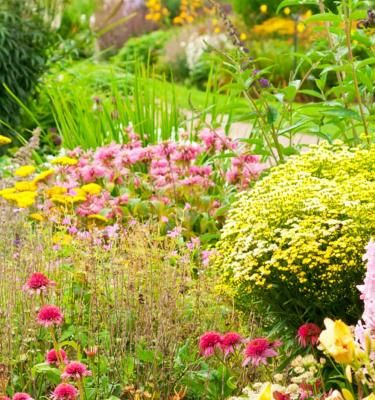In Australia we experience challenging climate conditions - that may bring periods of dry and wet conditions.
Growing a beautiful garden in dry conditions is always going to be challenging but it can be made easier with:
- Healthy soil
- Choosing the right plants
- Water saving tips and tricks
Dry proofing your garden
A garden can be as fragile or robust as you choose. With the right plants, proper training and a few tips and tricks, you can create a beautiful garden that won’t wilt without water.
Healthy Soil
Dry-proofing your garden starts with the soil.
- Improve its structure by adding bulk quantities of organics like compost and aged manures.
- Work the soil by forking or digging it over, to improve air and water penetration.
- Mulch to a depth of 7-10cm with an organic mulch to minimise water loss and keep the soil cool.
- More tips on creating healthy soil.
The right plants
Some plants will cope better in dry conditions than others, but that doesn’t mean that you should only plant cacti!
- Plant for your climate:
Plants that grow well in your climate will be the better performers in your garden. Those needing a lot of nurturing in order to survive will be the first to collapse under trying circumstances.
- Look for drought-tolerant or water-efficient plants:
Plants originating in the Mediterranean region have adapted to endure long periods without supplementary water. These include olives, geraniums and, yes, even roses.
For guidance on what will not only survive but thrive in your area, look at neighbours' gardens, browse your local garden centre or refer to a good Australian gardening book on the subject.
- Use foliage colour and form for maximum impact. Grey and thick-leaved plants are generally very water efficient and drought tolerant, so design a garden that makes the most of these plants. Look for foliage colour and texture to add interest and contrast to your garden throughout the year.
- Buy quality, healthy plants
The bargain corner of the nursery may seem ok, but you can be buying a cheap headache. Look for healthy plants that will be able to cope with having to survive in the garden, rather than struggling plants that need nurturing.
Water saving tips and tricks
There are many ways to save water and still keep your garden growing well.
|
Teach your plants to search for water |
When you water the garden, do so for a longer period of time but less often - so that water soaks deep down into the soil. This encourages plants to develop extensive root systems that are more dry tolerant. Short daily watering is an absolute 'no-no' if you want to teach your plants to be more self-sufficient and your garden to survive. |
|
Group thirsty plants together |
If you must have a couple of 'water-dependent' plants, try growing them in close proximity to one another so you only need to watch and frequently water that one small area, rather than the entire garden. |
|
Remove weeds |
Weeds need water too and they usually are far more efficient at getting it than most of your garden plants. Removing weeds reduces competition and makes sure the plants you want to keep are getting the water. |
|
Mulch with an organic mulch |
Reduce moisture loss from the soil (evaporation) and plants (transpiration) by adding an insulating mulch over the soil. It keeps the soil cooler and also reduces reflected heat from the soil surface, cooling the air around plants. Mulch also helps control weeds, so it's a win-win situation for your garden. |
|
Water the roots, not the leaves |
Plants take in water and nutrients from the soil through their roots. Make sure you water the soil around plants and apply enough to reach the entire root zone. Watering the foliage may cool the plants down briefly after a hot day but it also encourages fungal problems to develop. Water droplets on leaves may also cause burn spots - the heat of the sun is amplified through the water resulting in leaves being burned or scorched. |
|
When water is scarce |
Focus on the areas that need it most. These could be those nearest the house. If choices must be made, think carefully about which plants to save. Generally. they should be the most established and/or expensive. Usually, if the garden is well prepared, deep watering once every two weeks is enough to keep plants alive during a drought. |












